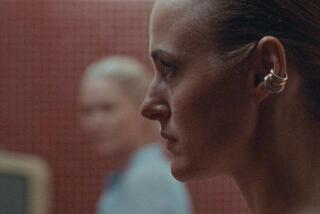MOVIE REVIEW : ‘Stecchino’ Doubles the Fun : Italian director-star Roberto Benigni brings a delightful wide-eyed style to this wish-fulfilling film about mistaken identity.
- Share via
Roberto Benigni, the writer-director-star of “Johnny Stecchino,” (at the Hillcrest Cinemas) shares one major quality with the great silent movie comics, the Chaplins and Keatons. Somehow, he seems not quite of this Earth.
With his elfin, pointy face and tiny, agile frame, he’s a moon child, a glorious freak. When Benigni begins his specialty--a rapid, almost brain-dizzying patter, where his maniacal discourse and flailing arms shred all logic to tatters--his voice and persona take on weird, musical tones, like Gabrieli’s trumpet with a frog in the bell.
“Johnny Stecchino,” a showcase for Benigni, was the biggest box-office hit in the history of the Italian movie industry, bigger than “La Dolce Vita” or “Cinema Paradiso.” But it’s unlikely to strike that universal a chord here. It’s a classic star vehicle: a simple romantic crime comedy about an accident-prone bus driver, Dante, who unknowingly assumes the role of his look-alike Sicilian gangster, Johnny. It exists mainly to show Benigni off, let him daffily race through his repertoire.
But, if you don’t recognize Benigni--and, though he’s a first-magnitude Italian star, most American audiences know him only from his Jim Jarmusch films--if, in a way, you aren’t rooting for him, it’s not quite as funny.
The movie is a sendup of machismo and the Mafia. In it, Johnny’s wife Maria (Nicoletta Braschi, Signora Benigni) and his coke-addled lawyer (Paolo Bonacelli) engineer the switch to provide the gangster’s many enemies with a plausible corpse, so the real Johnny, hidden in his villa basement, can flee Palermo for Argentina. But there’s another symbolic layer to this story: “Stecchino” means “toothpick” in Italian, and the “Johnny Toothpick” character is, in some sense, the evil fantasy-come-true of hapless Dante.
Like most “double” movies, from “Prince and the Pauper” to “The Prisoner of Zenda,” it’s a secret wish-fulfillment tale. Dante, a bumbling but benevolent little bus driver, goes woozy whenever he sees a beautiful woman. Johnny is a gravelly voiced lady-killer brute, who kills without qualm and slaps gorgeous Maria if she kisses him during sex.
And though kind little Dante, who serenades his busful of beaming, learning-impaired passengers with a jolly zoo song, shows no apparent desire to be a brutal gangster, it’s down there underneath. He’d like the power, the freedom, certainly the sex.
The movie strips his id, lets him play at being bad Al Pacino. But it’s a crucial plot twist that Dante never knows he’s been substituted for a notorious criminal. Instead, he accepts all the crazy lies and misconceptions Maria and Johnny’s shyster attorney keep feeding him: that the gourmet meals sent down to Johnny are being fed to a ravenous pet dog; that the lawyer’s cocaine is diabetes medicine, snorted through a lira bill; that, when the town erupts in gunfire or half a Palermo opera audience screams for the impostor’s head, it’s because he’s stolen a banana.
That’s how Dante keeps his innocence. His naivete is immense. But no more so, really, than killer Johnny, who falls into a trance whenever he hears the word mother , and keeps complaining that the “wimp” Dante doesn’t look anything like him. They’re alter egos, like swinger Buddy Love and schlemiel Julius Kelp in Jerry Lewis’ “The Nutty Professor,” and they even have complementary personal phallic symbols: Dante’s bananas and Johnny’s toothpicks. When they meet, appropriately, it’s in another reprise of the legendary two men and a mirror gag from Max Lindner and the Marx Brothers.
As an actor, Benigni is unique. Like Chaplin, Laurel or Hardy, he’s a human mixed metaphor: a devilish cherub, a seraphic imp. (In “Il Piccolo Diavolo,” he played a brash little demon who fell in love with the priest who exorcised him.) As a director, his style is big, clean, lucid. All the characters are snazzily exaggerated, and cinematographer Giuseppe Lanci’s shots of Palermo have sumptuous size and spaciousness.
As a writer, like many comics, he tends to string together set pieces, sometimes illogically. Dante is boob or would-be sharpster, Maria shifts too swiftly from murderess to heroine. And it’s hard to figure why everyone in town mistakes Dante for Johnny, except the police colonel to whom he confesses his “banana robbery.”
What buoys “Johnny Stecchino” (MPAA-rated R for language and drug-related humor) is its impudence, its tender-hearted wackiness, its revelry in all the squirrelly quirks of Benigni’s beguilingly screw-loose persona. The movie is a nose-tweak of the Mafia, government and organized religion, but there’s a wide-eyed style that softens its roughest gags. That tone is wonderful, childlike, unmalicious. If not quite benign, at least it’s Benigni.
‘Johnny Stecchino’
Roberto Benigni: Dante/Johnny Stecchino
Nicoletta Braschi: Maria Stecchino
Paolo Bonacelli: D’Agata
Ignazio Pappalardo: Cozzamara
A New Line Cinema release. Director Roberto Benigni. Producer Mario & Vittorio Cecchi Gori. Screenplay by Vincenzo Cerami, Benigni. Cinematographer Giuseppe Lanci. Editor Nino Baragli. Costumes Gianna Gissi. Music Evan Lurie. Art director Paolo Biagetti. Running time: 1 hour, 40 minutes.
MPAA-rated R (Language and drug-related humor).
More to Read
Only good movies
Get the Indie Focus newsletter, Mark Olsen's weekly guide to the world of cinema.
You may occasionally receive promotional content from the Los Angeles Times.










